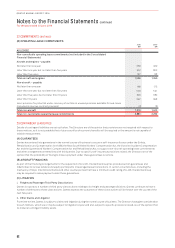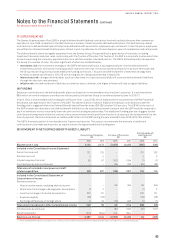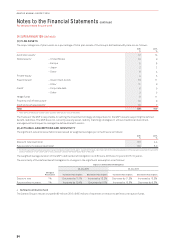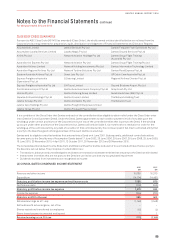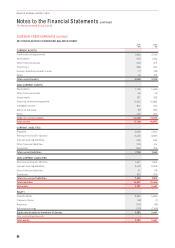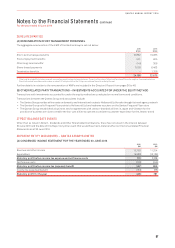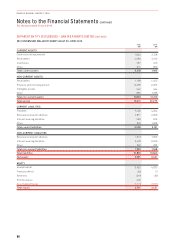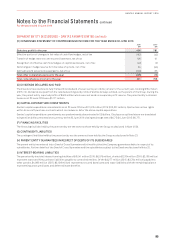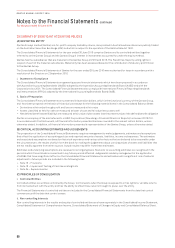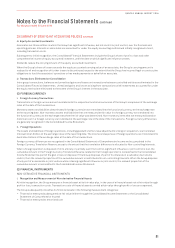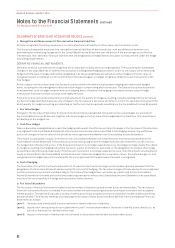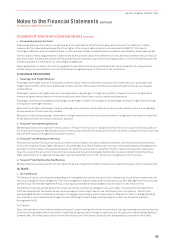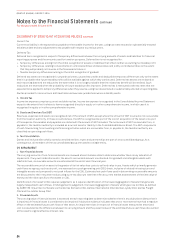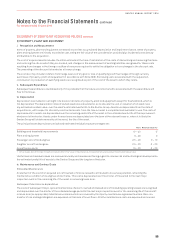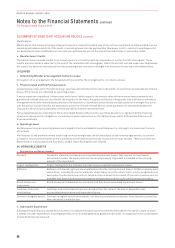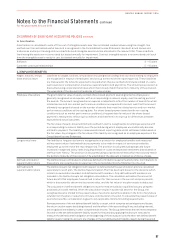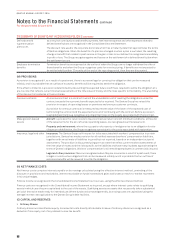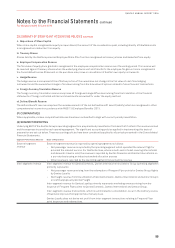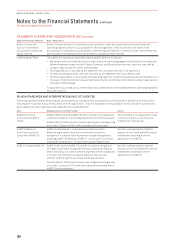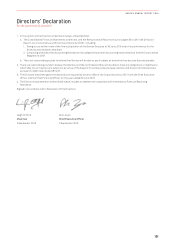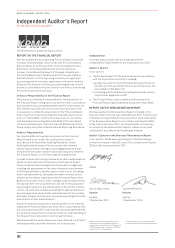Qantas 2016 Annual Report Download - page 94
Download and view the complete annual report
Please find page 94 of the 2016 Qantas annual report below. You can navigate through the pages in the report by either clicking on the pages listed below, or by using the keyword search tool below to find specific information within the annual report.
Notes to the Financial Statements continued
For the year ended 30 June 2016
29 SUMMARY OF SIGNIFICANT ACCOUNTING POLICIES CONTINUED
ii. Recognition and Measurement of Non-derivative Financial Liabilities
At initial recognition, the Group measures a non-derivative financial liability at its fair value, less transaction costs.
The Group subsequently measures non-derivative financial liabilities at amortised cost, with any difference between cost
and
redemption value being recognised in the Consolidated Income Statement over the period of the borrowings on an effective
interest basis. Non-derivative financial liabilities that are designated as hedged items are subject to measurement under the hedge
accounting requirements.
DERIVATIVE FINANCIAL INSTRUMENTS
Derivative financial instruments are recognised at fair value both initially and on an ongoing basis. The accounting for subsequent
changes in fair value depends on whether the derivative is a designated hedging instrument, and if so, the nature of the item being
hedged and the type of hedge relationship designated. The Group designates derivatives as either hedges of the fair value of
recognised assets or liabilities or a firm commitment (fair value hedges), or hedges of highly probable forecast transactions (cash
flow hedges).
At the inception of the transactions, the Qantas Group documents the relationship between hedging instruments and hedged
items, including the risk management objective and strategy for undertaking each transaction. The Qantas Group also documents
its assessment, both at hedge inception and on an ongoing basis, of whether the hedging instruments that are used in hedge
transactions have been and will continue to be highly effective.
From time to time certain derivative financial instruments do not qualify for hedge accounting, notwithstanding that the derivatives
are held to hedge identified exposures. Any changes in the fair value of a derivative instrument, or part of a derivative instrument that
do not qualify for hedge accounting are classified as ‘ineffective’ and recognised immediately in the Consolidated Income Statement.
i. Fair Value Hedges
Changes in the fair value of derivative financial instruments that are designated and qualify as fair value hedges are recorded in
the Consolidated Income Statement, together with any changes in the fair value of the hedged asset or liability or firm commitment
attributable to the hedged risk.
ii. Cash Flow Hedges
Where a derivative is designated as a cash flow hedging instrument, the effective portion of changes in the fair value of the derivative
is recognised in the Consolidated Statement of Comprehensive Income and accumulated in the hedging reserve. Any ineffective
portion of changes in the fair value of the derivative are recognised immediately in the Consolidated Income Statement.
The amount accumulated in equity is retained in the Consolidated Statement of Comprehensive Income and reclassified to the
Consolidated Income Statement in the same period or periods during which the hedged forecast cash flows affect profit or loss or
the hedged item affects profit or loss. If the forecast transaction is no longer expected to occur, the hedge no longer meets the criteria
for hedge accounting, the hedging instrument expires or is sold, terminated or exercised, or the designation is revoked, then hedge
accounting is discontinued prospectively. If the forecast transaction is no longer expected to occur, then the amount accumulated in
equity is reclassified to the Consolidated Income Statement. Where the hedged item is capital in nature, the cumulative gain or loss
recognised in the hedge reserve is transferred to the carrying amount of the asset when the asset is recognised.
iii. Cost of Hedging
The time value of an option, the forward element of a forward contract and any foreign currency basis spread is excluded from the
designation of a financial instrument and accounted for as a cost of hedging. The fair value changes of these elements are recognised
in other comprehensive income and depending on the nature of the hedged item, will either be transferred to the Consolidated
Income Statement in the same period that the underlying transaction affects the Consolidated Income Statement or be capitalised
into the initial carrying value of a hedge and reported as ineffectiveness.
iv. Fair Value Calculations
The fair value of financial instruments traded in active markets is based on quoted market prices at balance date. The fair value of
financial instruments that are not traded in an active market are estimated using valuation techniques consistent with accepted
market practice. The Qantas Group uses a variety of methods and input assumptions that are based on market conditions existing
at balance date. The different methods of estimating the fair value of these items have been defined in the Consolidated Financial
Statements as follows:
Level 1: Quoted prices (unadjusted) in active markets for identical assets or liabilities
Level 2: Inputs other than quoted prices included within Level 1 that are observable for the asset or liability, either directly (i.e. as
prices) or indirectly (i.e. derived from prices)
Level 3: Inputs for the asset or liability that are not based on observable market data (unobservable inputs)
92
QANTAS ANNUAL REPORT 2016


